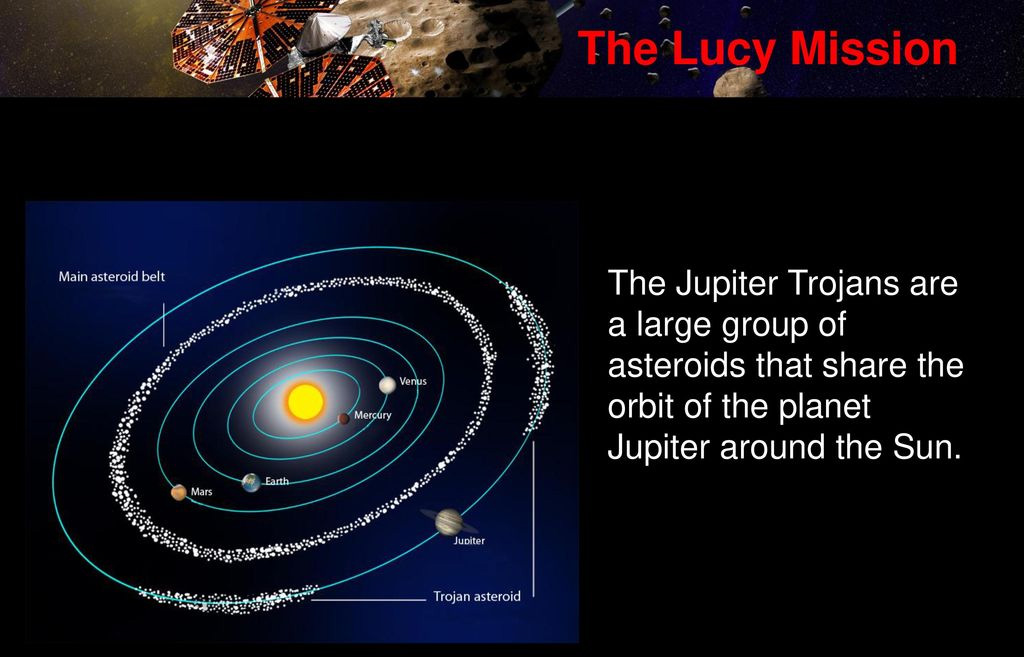Mission Lucy: NASA
Why in News
National Aeronautics and Space Administration (NASA) is set to launch ‘Lucy’, its first mission to explore the Jupiter Trojan Asteroids.
Key Notes
- Mission Lucy:
- Duration:
- The solar-powered mission is estimated to be over 12 years long, during which the spacecraft will visit eight asteroids covering a distance of about 6.3 billion km to deepen the understanding of the “young solar system”.
- Name and Launch:
- The mission is named after ‘Lucy’, a 3.2 million-year-old ancestor who belonged to a species of hominins (which include humans and their ancestors). The spacecraft will be launched on an Atlas V 401 rocket.
- Asteroid Donald Johnson:
- The spacecraft’s first encounter will be with an asteroid that lies in the main belt that can be found between Mars and Jupiter. This asteroid is named ‘Donald Johnson’ after the paleoanthropologist who discovered the fossilised remains of ‘Lucy’.
- Duration:
- Significance:
- The Trojan asteroids are believed to be formed from the same material that led to the formation of planets nearly 4 billion years ago when the solar system was formed.
- Therefore, the mission is designed to understand the composition of the diverse asteroids that are a part of the Trojan asteroid swarms, to determine the mass and densities of the materials and to look for and study the satellites and rings that may orbit the Trojan asteroids.
- Studying them will help scientists understand its origins and evolution, and why it looks the way it does.
Asteroids
- About:
- Asteroids are rocky objects that orbit the Sun, much smaller than planets. They are also called minor planets.
- Categories:
- Main Belt of Asteroids:
- First, those found in the main asteroid belt, between Mars and Jupiter. This region is estimated to contain somewhere between 1.1-1.9 million asteroids.
- Trojan:
- The second group is that of trojans (the name comes from Greek mythology), which are asteroids that share an orbit with a larger planet.
- NASA reports the presence of Jupiter, Neptune and Mars trojans. In 2011, they reported an Earth trojan as well.
- The Jupiter asteroids can be found in what are referred to as “swarms” that lead and follow the planet Jupiter along its orbit around the Sun.
- ‘Lucy’ will reach the first swarm of these asteroids that precede Jupiter by August 2027.
- These asteroids are believed to be the remnants of the early solar system.
- Near-Earth Asteroids:
- The third classification of asteroids is under Near-Earth Asteroids (NEA), which has orbits that pass close to the Earth. Those that cross the Earth’s orbit are called Earth-crossers.
- More than 10,000 such asteroids are known, of which over 1,400 are classified as Potentially Hazardous Asteroids (PHAs).
- Main Belt of Asteroids:
Jupiter
- Fifth in line from the Sun, Jupiter is, by far, the largest planet in the solar system – more than twice as massive as all the other planets combined.
- Jupiter, Saturn, Uranus and Neptune are called Jovian or Gas Giant Planets. These have thick atmospheres, mostly of helium and hydrogen.
- Jupiter rotates once about every 10 hours (a Jovian day), but takes about 12 Earth years to complete one orbit of the Sun (a Jovian year). Jupiter has more than 75 moons.
- The major moons of Jupiter are named Io, Europa, Ganymede, and Callisto, which are each distinctive worlds.
- In 1979, the Voyager mission discovered Jupiter’s faint ring system. Nine spacecraft have visited Jupiter. Seven flew by and two have orbited the gas giant. Juno, the most recent, arrived at Jupiter in 2016.
